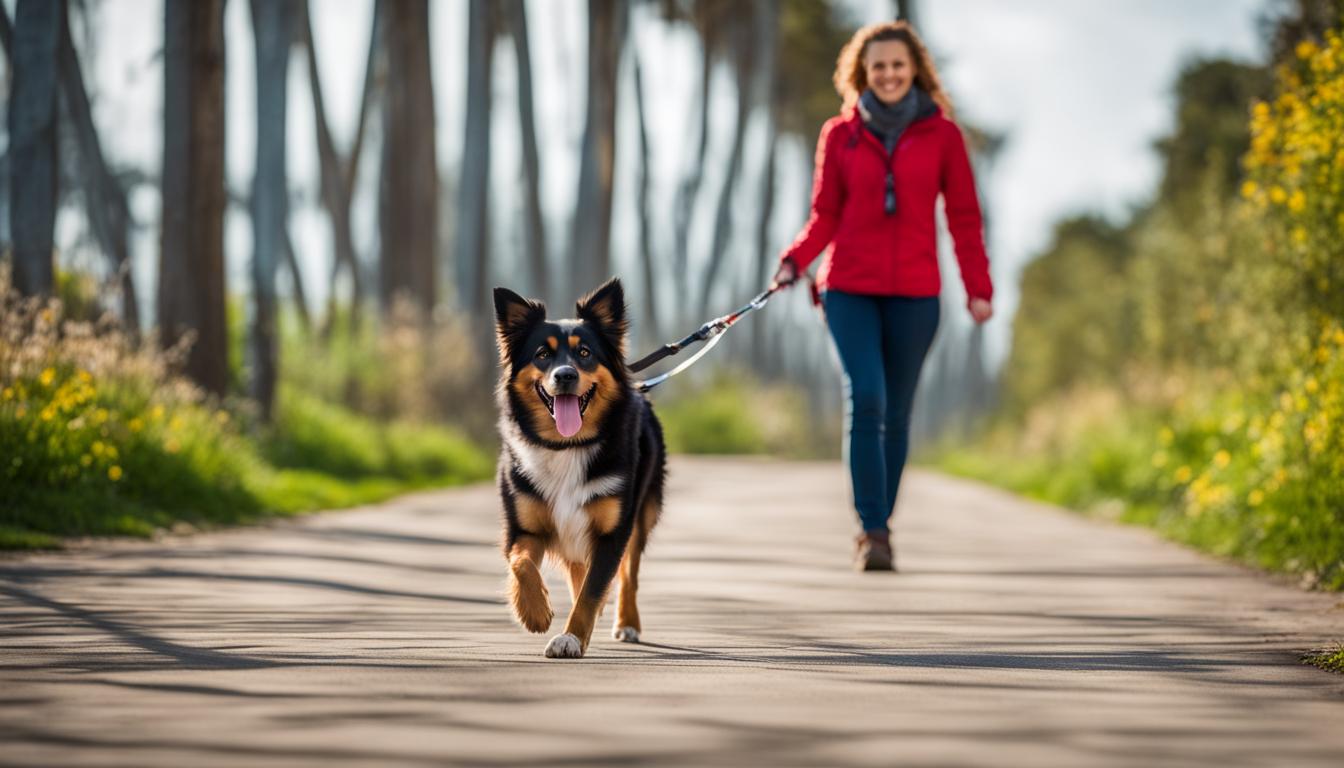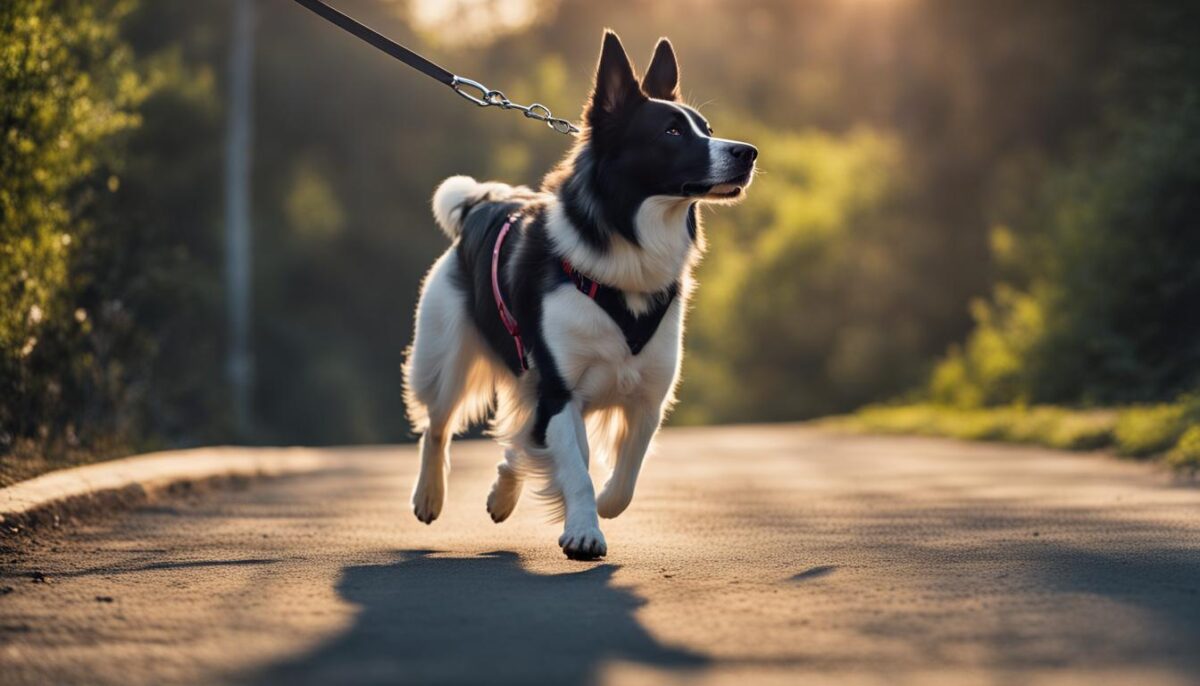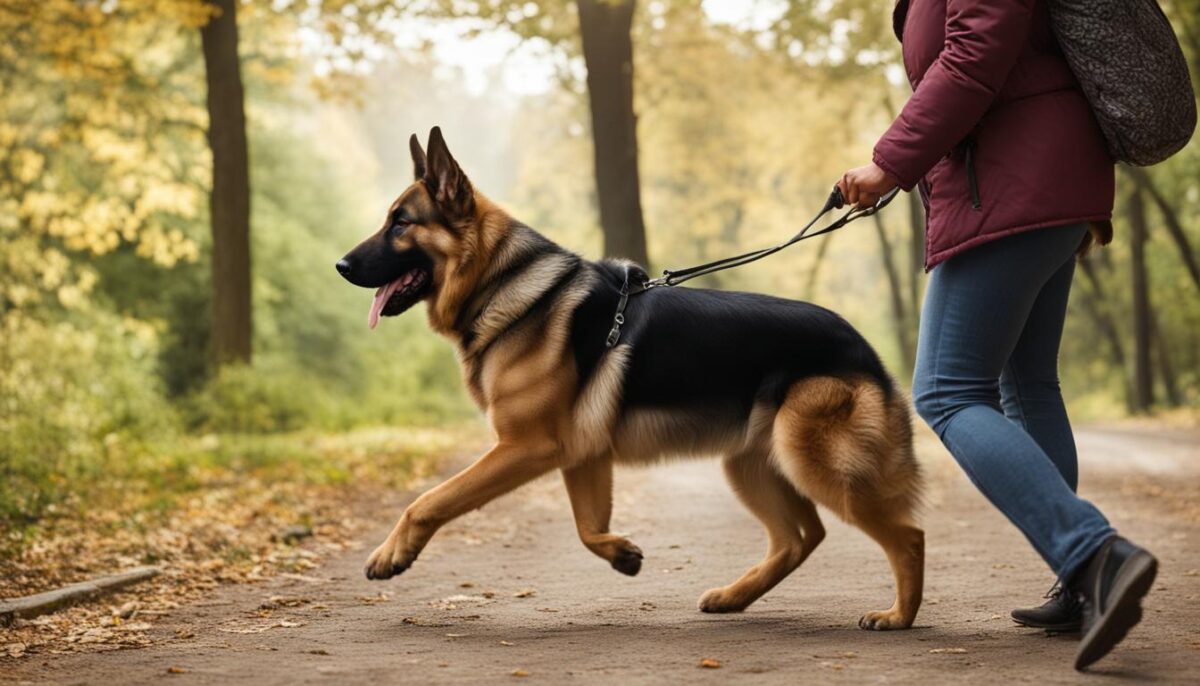If you have a young pup or an older dog, learning to heel is like a game you play together. Imagine walking with your furry friend nicely by your side. No more pulling on the leash! You’ll need some good treats cut up and a big space in your house to start.
Begin by asking your dog to come to your side. When they do it right, say “yes” or click and give them a treat. Try this more times without calling them and give lots of praise and treats when they come to your side. Soon, start moving and make it a fun challenge to keep eye contact. Remember, treat from the hand on your dog’s side, and let them know they are doing great!
Key Takeaways
- Making heeling fun like a game with treats and praise
- Start in a big room in your home without distractions
- Treats should come from the hand on your dog’s side
- Use happy words or a clicker when your dog heels right
- Practice makes perfect, keep trying!
The Joys and Benefits of Teaching Your Dog to Heel
When you teach your dog to heel, you’re doing much more than just teaching a trick. You’re giving them a way to focus and you’re making your walks together better. Let’s talk about what’s so great about this command.
The Mental Exercise of Heeling
Mental stimulation for dogs is just as important as physical exercise. When your dog learns to heel, it’s like a fun brain game. They stay relaxed because they need to concentrate on following your steps and staying close. This keeps their mind busy and makes them happy!
Building a Bond Through Heel Training
Heel training is also a special way for you and your dog to become closer friends. It’s like a dance where you both move together. Bonding with your dog happens here because they look at you for guidance and learn to trust you. Plus, it’s fun to learn new things with your buddy!
The Practicality of Heeling in Busy Environments
Knowing practical dog commands like heel is super helpful when you are in places with many people or other dogs. It keeps your dog safe and by your side, making safe dog walking a breeze. Heeling benefits you both because there’s less tugging and more enjoying your walk together. Obedience training can be a big help for those busy sidewalks and parks!
Understanding the Heel Command
When you take your dog out for a walk, have you ever noticed other dogs walking nicely by their owner’s side? They are following a special rule called the “heel command.” Let’s learn what that means and how it’s different from a regular walk with your furry friend!
The Formal Definition of “Heel”
The heel command definition is pretty simple. It tells your dog to walk right next to you, not ahead or behind, and to do it without being distracted by other things. Imagine your dog is like a shadow, sticking close to your side as you walk.
How Heel Differs from Regular Walking
When you’re just walking your dog, they can sniff around, wander a bit, and have a bit of fun. But, when you’re doing disciplined dog walks, it’s more about staying focused. Think of it like being in a classroom – it’s a time for learning and paying close attention to obedience training commands. And just like in school, you’re the teacher, guiding your dog and helping them learn where to be – that’s the canine heel position, right by your side!
A well-trained heel can turn a regular walk into a moment of bonding and learning. It’s not just about exercise; it’s about working together as a team.
Preparation: Setting Up for Heel Training Success
Hey there, are you preparing for heel training? Let’s make sure you and your pup are set up for success! First, find a quiet place inside where there aren’t many things that could distract your dog. This will be your training setup.
Gather some small treats that your dog can’t resist. If you are going to use a special sound to let your dog know they’re doing great, have a clicker or decide on a happy word like “Yes!” Now, you’ll want to start by having your dog follow you with the treats. Take baby steps at first, then ask for more steps from your doggie as you go. Remember, praise your dog and hand them treats when they do what you want; this is a super important part of successful dog training tips!
| Training Tool | How to Use It | Tips for Success |
|---|---|---|
| Treats | Start with luring your dog by the side you want them to walk on | Use small, yummy treats to keep your dog’s interest |
| Clicker/Word Marker | Use right after your dog does something good | Be quick so your dog knows exactly what they did right |
| Quiet Indoor Space | Begin training away from loud noises and other pets | Less distractions mean your dog can focus on learning |
So, buddy, are you ready to have some fun training your dog to heel? Let’s get going with these successful dog training tips and make your walks with your furry friend even better!
How to Train a Dog to Heel: The Step-by-Step Guide
Teaching your dog to walk beside you without pulling on the leash is easier than you might think! With some treats and patience, you can show your furry friend how it’s done. Just follow this simple guide, and you’ll be walking together in no time. Remember, practice makes perfect!
With Treats as Lures
Get a yummy treat and hold it in your hand. Let your dog sniff it, then walk a little bit and watch your dog follow! When you stop, give your dog the treat and say “Good job!” Try doing this for about ten steps to start with. As your dog gets better, walk more steps before stopping for the treat.
Incorporating Hand Signals
Now, add a special hand sign! Tap your leg and say “heel” to ask your dog to walk beside you. Walk together and every few steps, tap your leg and give that hand signal. Give your dog a treat from the hand on the same side they’re walking. Soon, your dog will know that “heel” means to stick close to you.
Gradually Increasing Complexity
Once your dog is good at following the treat, try new moves like turning around or walking in a figure eight. Say “heel” every time and use your hand signal. Always start where it’s quiet so your dog can focus, then you can try walking outside. Mix up these heel walks with your regular walks to keep it fun!
Remember, when you’re training with treats, don’t forget to still give lots of praise. Your voice can be just as good as a treat to let your dog know they’re doing great! If your dog is doing well, you can give treats less often but still say “Good dog!” a lot.
Here’s an easy table to follow for when to add more steps and challenges:
| Steps to Start | When to Add Hand Signals | When to Increase Complexity |
|---|---|---|
| 10 steps with treat lure | Once 10 steps are mastered | After hand signals are established |
| Add 5 more steps gradually | Use hand signal every few steps | Add turns and figure eights |
| Work up to no treat luring | Less frequent treats; more praise | Practice in different, safe locations |
With a bit of time and these fun exercises, your dog will learn to heel like a pro. Always keep it easy and playful, and enjoy your time training together!
Progressive Training: From Basic Heeling to Advanced Techniques
Once your furry friend has mastered basic heeling, it’s time for some new challenges. Progressive dog training steps up the game, introducing smarter ways to keep your dog’s focus sharp and their steps right next to yours.
Adding Distractions and Building Focus
Living in a busy world means learning to ignore the buzz around us. The same goes for your pooch during distraction training. Start simple, with just a few people around, and work your way up to busier places. Remember, rewarding your dog for keeping eyes on you is key! Let’s toss a treat their way when they do it right.
Teaching Heel on Different Terrains
Grass, gravel, or sidewalks—heeling on varied terrains keeps their minds and paws ready for anything. It’s like an adventure for your dog, with new sights and smells, but the mission is to stay by your side, come hill or high water!
- Start on flat, easy ground like your living room floor.
- Move to the backyard where the grass and earth feel different.
- Try a quiet park with paths for a bit of challenge.
- Graduate to hikes with a mix of rocks, roots, and dirt.
As you try these advanced heeling techniques, have a handful of treats ready for a job well done. And if your dog gets a little off track, no sweat! Just guide them back and keep the fun going.
Keep practice fun and your patience big, just like your dog’s heart. With your encouragement and focus building with dogs, they’ll be showing off their smooth heeling moves everywhere you go!
Here’s a little table to help you remember what to work on as you take your heeling practice up a notch. It’s like a progress chart that you and your four-legged buddy can check off together!
| Training Level | Environment | Focus Challenges |
|---|---|---|
| Beginner | Indoors, minimal distractions | Ignoring toys and other household items |
| Intermediate | Backyard, some distractions | Focusing with outdoor sights and sounds |
| Advanced | Public parks, lots of distractions | Maintaining heel among other people and dogs |
| Expert | Varied terrains, high distraction areas | Heeling through changing landscapes and busy environments |
Take your time and enjoy every step. Every day is a new chance to learn and grow with your tail-wagging pal, making your walks together that much more special!
Common Challenges and How to Troubleshoot Them
So you’re getting the hang of teaching your dog how to heel, but what happens when distractions pop up or your furry friend starts pulling or lagging? It’s all part of the learning curve, and with a few smart moves, you’ll be back on track!
Dealing with Distractions
Distractions are everywhere—squirrels, birds, and new smells. If your dog looks away or pulls during heel training, you can do a fun trick! Turn around and walk the other way, then use a thigh tap and say “heel” to get your dog’s attention back. This helps your puppy learn to focus on you instead of the distractions. Let’s practice this turning game a lot, so distractions become no big deal.
When Your Dog Pulls or Lags Behind
Pulling ahead can be a bit of a tug-of-war, but don’t worry. If your dog pulls, that same turn-around trick will help. It reminds your pooch to stay close to you. For a dog that lags behind, try walking a bit more exciting. Use a happy voice and tasty treats to cheer them on. Keeping training fun is key to success!
Keep in mind, heel training is like a special trick. It’s not for the whole walk—dogs love to explore too! Mixed with sniffing around and enjoying the walk, heeling will keep both you and your dog happy.
| Issue | Troubleshooting Step | Why it Works |
|---|---|---|
| Dog is distracted | Turn around and heel cue with thigh tap | Redirects focus back to trainer |
| Dog pulls ahead | Use same turn-around technique | Reinforces the need to stay close |
| Dog lags behind | Encourage with treats and a cheerful voice | Makes following and attention fun |
Conclusion
So, you’ve learned all about how to train your pup to walk nicely by your side with the heel command. It’s been a fun journey, right? And remember, it’s super important to keep at it. Just like you get better at a game the more you play, your dog gets better at heeling the more you practice. Keep using those small treats and your happy voice to tell your dog they’re doing a great job.
This heeling trick isn’t just to show off – it’s really useful too! When your dog knows how to heel, walks are safer and more fun. Plus, it’s like a brain game for your dog, making them think and pay attention. When you’re out and about, you can feel proud of how well your furry friend is listening to you.
Keep in mind, walks are meant to be happy times for sniffing around and having a bit of freedom too. Mixing up heeling with chill walking time makes for a happy pup. You’ve done an awesome job teaching your dog this cool skill. Now, go enjoy those walks together with your well-trained canine buddy!
FAQ
What is the heel command in dog training?
The heel command instructs your dog to walk directly beside you, matching your pace without pulling ahead, lagging behind, or getting distracted. It’s a disciplined way of walking that requires the dog to pay close attention and follow your lead.
How do dog heeling techniques differ from regular walking?
Unlike casual walks where dogs may have more freedom to explore, dog heeling techniques involve the dog walking closely beside you, paying close attention, and ignoring distractions like tempting smells or other animals, focusing instead on following your cues.
Can heel training for puppies and older dogs also provide mental stimulation?
Absolutely! Heel training for puppies and older dogs not only teaches them good walking habits but also provides mental exercise. It keeps their minds engaged as they focus on cues and work on maintaining the correct position beside you.
What are the benefits of heeling in busy environments?
Teaching your dog to heel is especially beneficial in busy environments. It can help maintain a safe distance from crowds and other potential hazards while keeping your dog from becoming a nuisance or danger to others. Heeling can also prevent your dog from getting overly stimulated by the environment.
Why is bonding with your dog important during heel training?
Bonding with your dog is crucial during heel training as it builds trust and communication between you and your pet. The training sessions are an opportunity to reinforce your relationship through positive reinforcement, making heeling a collaborative and enjoyable exercise for both of you.
How should I prepare for heel training?
Preparing for heel training involves gathering treats your dog loves, a clicker or verbal marker for communication, and selecting a quiet, distraction-free space to begin. Make sure you have a clear training plan and that you’re in the right mindset to train patiently and consistently.
Can I use hand signals for heeling during training?
Yes, hand signals can be a powerful tool during heel training. Incorporating a consistent hand signal, such as a tap on your thigh, can help communicate your expectations to your dog and assist them in learning the heel command more effectively.
What progressive dog training techniques can I use to advance my dog’s heeling skills?
To advance your dog’s heeling skills, you can introduce more challenging environments, add varying terrains, and gradually include distractions to build focus. You can also extend the duration and distance of heeling during your walks, always using positive reinforcement to maintain their good behavior.
How do I manage distractions when training my dog to heel?
When training your dog to heel, introduce distractions gradually in a controlled environment, use positive reinforcement to reward focus, and practice techniques like changing direction and repeating cues to redirect your dog’s attention when they become distracted.
What should I do if my dog pulls ahead or lags behind while learning to heel?
If your dog pulls ahead or lags, use positive reinforcement such as treats and praise to encourage the correct position. For dogs that pull, you might reverse direction and repeat the heel command with a clear signal. For lagging, gently encourage them with treats to stay beside you and be patient as you reinforce the desired behavior.


